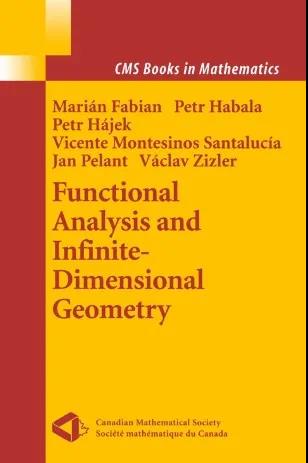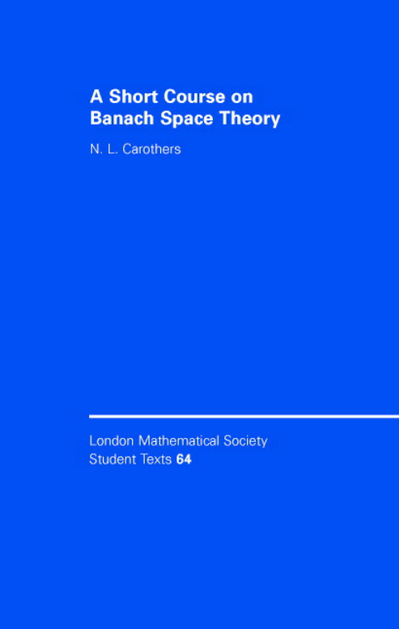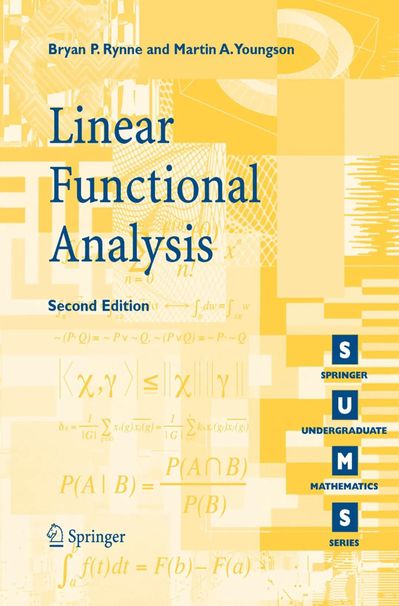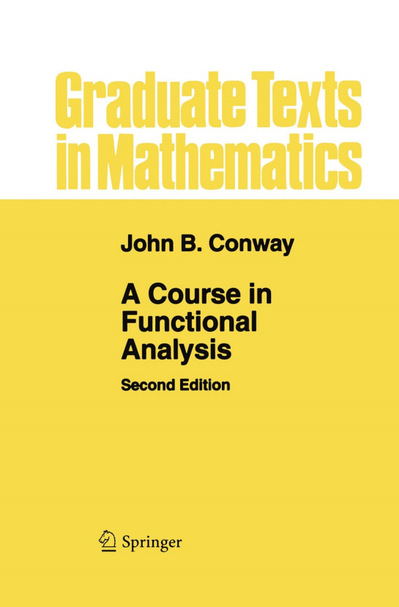目录
5 60 本教材点评
5.12 泛函分析 6 本

《Functional Analysis and Infinite-Dimensional Geometry》
作者:Fabian Marian; Habala Petr; Hajek Petr; Montesinos Santalucia Vicente; Pelant, Jan; Zizler, Vaclav
出版商:Springer
出版年:2001
ISBN:9780387952192
适用范围:研究生
推荐强度:9
作者简介:Marián Jan Fabian(1949-),捷克数学家,1972毕业于查尔斯大学数学分析专业;1979年在查尔斯大学获得泛函分析博士学位; 1995年在布拉格工业大学担任副教授(非正式教授);之后在捷克共和国科学院任数学研究所研究主任。
Petr Habala(1968-),捷克数学家,1992年毕业于查尔斯大学数学专业,1996年在加拿大埃德蒙顿阿尔伯塔大学获得数学博士学位,现任捷克布拉格技术大学(CVUT)电子工程学院数学系副教授。
Petr Hájek(1940-2016),是捷克数理逻辑领域的科学家和数学教授。出生在布拉格,他在捷克共和国科学院的计算机科学研究所工作,在布拉格查尔斯大学数学和物理系与布拉格捷克技术大学的核科学和物理工程学院任讲师。
Vicente Montesinos Santalucía目前是西班牙瓦伦西亚理工大学应用数学系的正教授和纯数学与应用数学研究所的研究员。他的研究领域是泛函分析,专攻巴拿赫空间理论。他是50多篇列在MathSciNet上的研究论文的作者,还写过几篇研究论文(其中三篇由Springer出版)和几本教学书籍(瓦伦西亚理工大学)。他是西班牙科学院的通讯成员。
Jan Pelant(1950-2005),捷克数学家,他于1976年加入捷克斯洛伐克科学院数学研究所,他的研究领域包括点集拓扑,泛函分析和组合数学。Jan对点集拓扑的贡献范围很广,主要集中在点集拓扑的以下四个领域:一致空间,紧空间,连续函数空间和超空间。
Vaclav Zizler(1943-),捷克数学教授,专攻巴纳赫空间理论和非线性空间。自2006年起,Zizler担任加拿大埃德蒙顿阿尔伯塔大学名誉教授。他曾在捷克科学院的数学研究所担任研究负责人。2001年,捷克教育部长将他的《Functional Analysis and Infinite Dimensional Geometry》评为年度大学教科书。他在2008年因为在数学分析和为捷克数学无私奉献的终身卓越工作,被捷克数学学会授予了荣誉奖章。
书评:
This book is based on graduate courses taught at the University of Alberta in Edmonton. It is intended as an introduction to linear functional analysis and to some parts of infinite-dimensional Banach space theory. It is full of facts, theorems, corollaries; along with a large number of exercises with detailed hints for their solution.
Chapter 1 – Basic Concepts in Banach Spaces; Chapter 2 – Hahn-Banach and Banach Open Mapping Theorems; Chapter 3 – Weak Topologies; and Chapter 7 – Compact Operators on Banach Spaces, is basic material for functional analysis. Not so basic are: Chapter 4 – Locally Convex Spaces; Chapter 5 – Structure of Banach Spaces; and Chapter 6 – Schauder Bases. Most of the material in Chapter 8 – Differentiability of Norms; Chapter 9 – Uniform Convexity; Chapter 10 – Smoothness and Structure; Chapter 11 – Weakly Compactly Generated Spaces; and Chapter 12 – Topics in Weak Topology, has been developed in the past fourty years.
The authors have accomplished a text which is easily readable and as self-contained as possible. A very excellent book for the topics covered!
点评人:Joe Howard (Portales/New Mexico)
In his recent published autobiography , the great French analyst Laurent Schwartz muses: 'For a while [in the 1950s and 1960s], the surge of enthusiasm for topological vector spaces led people to believe that Banach spaces had finished their career ... But... today, it is the theory of topological vector spaces which can be considered as finished - indeed, it is enough to know some of the major theorems ..., the rest having become a little obsolete - whereas Banach spaces have returned in triumph ... There are deep and difficult areas within this theory.' Various factors may be cited in connection with this resurgence of interest in Banach space theory. Firstly, there has been an infusion of new techniques from other areas of mathematics such as logic, combinatorics and probability. Secondly, there has been a growing realisation of the richness of the geometrical aspects of Banach spaces, especially the subtleties of certain norm-specific features. And finally, several long-standing problems, including some dating back to Banach himself, have been resolved in recent years. All six authors of Functional analysis and infinite-dimensional geometry have been involved with giving or receiving graduate courses in functional analysis at the University of Edmonton in the 1980s and 1990s. This book represents a distillation of their experience and expertise and, although their individual research interests may be discerned from the later chapters, the writing is remarkably homogeneous in tone and appearance. Approximately half of the book is introductory in character covering the familiar material of an advanced undergraduate/beginning graduate course in linear functional analysis, together with the spectral theory of compact operators, weak topologies (including the James boundary) and locally convex spaces (including the bipolar theorem and the Mackey topology). This is pretty much the canon of knowledge alluded to by Schwartz and treated by Dieudonne in his history of this area, The rest of the book is a 'What happens next?' account of topics suitable for a more advanced graduate course and serves as an introduction to some of the major themes in Banach space research over the last 30 or so years. The later chapters thus focus on structure (projections and complements), Schauder bases (including the James space), Gateaux and Frechet differentiability of norms (smoothness and structure), uniform convexity (up to trees and the equivalence of superreflexive with the existence of an equivalent uniformly convex norm), weakly compactly generated spaces (up to the DFJP factorisation theorem) and some weak topology aspects of C(K) for various classes of compact spaces, K. To the uninitiated, it can sometimes be difficult to see the wood for the trees in this area which all too easily can appear as an amalgam of clever one-off techniques together with an almost superhuman appreciation of the idiosyncrasies of individual Banach spaces. Here, though, the sextet of authors have done a superb job in marshalling and presenting their material: the writing is crisp and authoritative and they take full advantage of recent simplifications in the proofs of certain results. The fulsome, upto-date bibliography is accompanied by a marvellous collection of nearly 700 exercises (with integrated hints): for both learners and lecturers, this rich source of material alone is worth more than the cost of the book! Functional analysis and infinite-dimensional geometry would admirably complement a range of courses at the advanced graduate/graduate level. It is essentially self-contained and would, I think, be especially helpful as a reference book for someone starting research in this area. I warmly commend this book and endorse the authors' hope in the preface, 'We would be glad if this book inspired some young mathematicians to choose Banach spaces as their field of interest. We wish the readers a pleasant time spent over this book.
点评人:Nick Lord( The Mathematical Gazette, Vol. 87 (509), 2003)
书评:
本书基于坐落于加拿大埃德蒙顿的阿尔伯塔大学的研究生课程,旨在介绍线性泛函分析与无限维Banach空间理论的某些部分。本书内容详实,包含大量习题,伴有解法的提示。
第1章–Banach空间中的基本概念;第2章–Hahn-Banach定理与Banach开映射定理;第3章–弱拓扑;与第7章–Banach空间上的紧算子,是泛函分析中的基础内容。进阶内容包括:第4章–局部凸空间;第5章–Banach空间的结构;与第6章–Schauder基。而下列内容中的大部分则是近40年的研究成果:第8章–范数的可微性;第9章–一致凸性;第10章–光滑性与结构;第11章–弱紧生成空间;与第12章–弱拓扑中的命题。作者已经尽可能使其通俗易懂,又不需要过多预备知识。这是一本非常好的书。
点评人:Joe Howard(Zentralblatt MATH, Vol. 981, 2002)
伟大的法国数学家Laurent Schwartz在他最近出版的自传中写到:“在一段时间内(19世纪50年代与60年代),对拓扑向量空间日益高涨的热情使人们相信Banach空间的使命已经结束了。但是今天,有关拓扑向量空间的研究几乎已经走到尽头了——事实上,知道一些主要的定理就足够了,其余的已经有点过时了——而Banach空间却重新回到了研究者的视野中,这一理论中存在着深刻而困难的部分。”各种各样的因素促成了人们重新燃起对Banach空间理论的兴趣。首先,从数学的其他领域,如逻辑、组合数学和概率论,注入了新的技术。其次,人们越来越认识到Banach空间几何方面的丰富性,特别是某些特定范数下的特性的微妙之处。最后,一些长期存在的问题,包括一些可以追溯到Banach本人的问题,近年来得到了解决。Functional Analysis and Infinite Dimensional Geometry的所有六位作者都或是讲过,或是听过在20世纪八九十年代在埃德蒙顿大学开设的泛函分析研究生课程。这本书代表了他们教学经验与专业知识的升华,虽然可以从后面的章节中看出他们的研究兴趣各不相同,但在整体基调和文字表现上,他们的写作具有高度的一致性。本书大约一半内容是介绍性的,涵盖了线性泛函分析高年级本科生/研究生课程的常见内容,以及紧算子的谱理论,弱拓扑(包括James边界)和局部凸空间(包括双极性定理和Mackey拓扑)。这几乎就是历史上Schwartz所提到的、Dieudonne所研究的经典内容,本书的其余部分是“接下来会发生什么?”,包括适合更高年级研究生课程的内容,介绍了近30年来Banach空间研究中一些主要主题。因此,后面的章节将重点讨论结构(射影空间与补空间)、Schauder基(包括James空间)、范数的Gateaux和Frechet可微性(光滑性和结构)、一致凸性(直到树以及存在等价一致凸范数与超自反的等价性),弱紧生成空间(直到DFJP分解定理)和对于各类紧空间K,C(K)的一些弱拓扑方面的结论。对于外行来说,有时会只能看到细节而无法全面地关注整体,因为这一领域很容易被看作是一些精妙数学技术的融合体,再加上对个别Banach空间性质的特别关注。然而,在这里,六位作者在整理并呈现相关内容方面做了出色的工作:语言清晰而严谨,他们充分利用了最近的研究结果 ,简化了一些证明。本书给出了丰富的参考文献,并有近700道习题(伴有粗略的提示):对于学生和教师来说,这些内容是十分有价值的。Functional Analysis and Infinite Dimensional Geometry是对研究生课程很好的补充。它基本上是自成体系的,我认为,本书作为一本参考书,对这一领域的初学者特别有帮助。我强烈推荐这本书,并赞同作者在序言中的看法,如果这本书能启发一些年轻数学家选择Banach空间作为他们感兴趣的领域,我们会很高兴。我们祝读者在这本书上能有一段愉快的时光。
点评人:Nick Lord(The Mathematical Gazette, Vol. 87 (509), 2003)
资料整理:孟文斌
翻译:赵旭彤

《Principles of Functional Analysis》
作者:Martin Schechter
出版商:American Mathematical Society
出版年:2001
ISBN:9780821828953
适用范围:本科生
推荐强度:9
作者简介:Martin Schechter(1930-),美国数学家,他的研究领域是数学分析(特别是偏微分方程和泛函分析及其在数学物理中的应用)。他是加州大学欧文分校的教授。他还是正统犹太科学家协会的成员。
书评:
This book provides a thorough introduction to (linear) functional analysis and operator theory in Banach and Hilbert spaces. There are no prerequisites except a course in advanced calculus and, for some chapters, an elementary knowledge of complex function theory. No measure theory is employed or mentioned. Only rudimentary topological or algebraic concepts are used. The value of the book is enhanced by the fact that each chapter ends with a section “Problems”, which will not be listed in the following table of contents:
Chapter 1. Basic Notions (1.1 A problem from differential equations, 1.2 An examination of the results, 1.3 Examples of Banach spaces, 1.4 Fourier series).
Chapter 2. Duality (2.1 The Riesz representation theorem, 2.2 The Hahn-Banach theorem, 2.3 Consequences of the Hahn-Banach theorem, 2.4 Examples of dual spaces).
Chapter 3. Linear Operators (3.1 Basic properties, 3.2 The adjoint operator, 3.3 Annihilators, 3.4 The inverse operator, 3.5 Operators with closed ranges, 3.6 The uniform boundedness principle, 3.7 The open mapping theorem).
Chapter 4. The Riesz theory for compact operators (4.1 A type of integral equation, 4.2 Operators of finite rank, 4.3 Compact operators, 4.4 The adjoint of a compact operator).
Chapter 5. Fredholm operators (5.1 Orientation, 5.2 Further properties, 5.3 Perturbation theory, 5.4 The adjoint operator, 5.5 A special case, 5.6 Semi-Fredholm operators, 5.7 Products of operators).
Chapter 6. Spectral theory (6.1 The spectrum and resolvent sets, 6.2 The spectral mapping theorem, 6.3 Operational calculus, 6.4 Spectral projections, 6.5 Complexification, 6.6 The complex Hahn-Banach theorem, 6.7 A geometric lemma).
Chapter 7. Unbounded operators (7.1 Unbounded Fredholm operators, 7.2 Further properties, 7.3 Operators with closed ranges, 7.4 Total subsets, 7.5 The essential spectrum, 7.6 Unbounded semi-Fredholm operators, 7.7 The adjoint of a product of operators).
Chapter 8. Reflexive Banach spaces (8.1 Properties of reflexive spaces, 8.2 Saturated subspaces, 8.3 Separable spaces, 8.4 Weak convergence, 8.5 Examples, 8.6 Completing a normed vector space).
Chapter 9. Banach algebras (9.1 Introduction, 9.2 An example, 9.3 Commutative algebras, 9.4 Properties of maximal ideals, 9.5 Partially ordered sets, 9.6 Riesz operators, 9.7 Fredholm perturbations, 9.8 Semi-Fredholm perturbations, 9.9 Remarks).
Chapter 10. Semigroups (10.1 A differential equation, 10.2 Uniqueness, 10.3 Unbounded operators, 10.4 The infinitesimal generator, 10.5 An approximation theorem).
Chapter 11. Hilbert space (11.1 When is a Banach space a Hilbert space?, 11.2 Normal operators, 11.3 Approximation by operators of finite rank, 11.4 Integral operators, 11.5 Hyponormal operators).
Chapter 12. Bilinear forms (12.1 The numerical range, 12.2 The associated operator, 12.3 Symmetric forms, 12.4 Closed forms, 12.5 Closed extensions, 12.6 Closable operators, 12.7 Some proofs, 12.8 Some representation theorems, 12.9 Dissipative operators, 12.10 The case of a line or a strip, 12.11 Selfadjoint extensions).
Chapter 13. Selfadjoint operators (13.1 Orthogonal projections, 13.2 Square roots of operators, 13.3 A decomposition of operators, 13.4 Spectral resolution, 13.5 Some consequences, 13.6 Unbounded selfadjoint operators).
Chapter 14. Measures of operators (14.1 A seminorm, 14.2 Perturbation classes, 14.3 Related measures, 14.4 Measures of noncompactness, 14.5 The quotient space, 14.6 Strictly singular operators, 14.7 Norm perturbations, 14.8 Perturbation functions, 14.9 Factored perturbation functions).
Chapter 15. Examples and applications (15.1 A few remarks, 15.2 A differential operator, 15.3 Does A have a closed extension?, 15.4 The closure of A, 15.5 Another approach, 15.6 The Fourier transform, 15.7 Multiplication by a function, 15.8 More general operators, 15.9 BB-Compactness, 15.10 The adjoint of A¯¯¯¯A¯, 15.11 An integral operator).
This is an excellent book e.g. for somebody working in applied mathematics who wants to learn operator theory from scratch. It contains a wealth of material on (semi-) Fredholm operators and perturbations. The material is presented in a very elegant way, starting with motivations (for instance, see Chapter 1, sections 4.1, 10.1 etc.). The approach is substantially different than in most other mathematics books: As the author wrote in the introduction to the first edition, “After introducing the first topic, I try to follow a trend of thought wherever it may lead without stopping to fill in details. I do not try to describe a subject fully at the place it is introduced. Instead, I continue with my trend of thought until further information is needed. Then I introduce the required concept or theorem and continue with the discussion.” E.g., in 2.2 only the real case of the Hahn-Banach theorem is given since the author believes that the reader will see the advantage of complex Banach spaces only in Chapter 6. In 6.6 the complex form of the Hahn-Banach theorem is stated, and in 7.3 its geometric form is discussed. Zorn’s lemma appears in 9.5 for the first time. Rather often the author continues to explain his trend of thought, postponing (part of the) proofs. He certainly does this in a masterly fashion, and thus the book is very pleasant to read: Sometimes there are imaginary conversations between the author and the reader like after Theorem 6.8: “Hold a minute!” you exclaim. “You are using results for a complex Banach space that were proved only for real Banach spaces.” Yes, you are right. However,... (and so on).
Since there are practically no prerequisites, the book does not contain certain topics treated by many other textbooks on functional analysis. Fréchet spaces or locally convex spaces are not mentioned, only weak convergence of sequences occurs, but no weak topology. Consequently, only the elementary part of Gelfand theory is included in 9.3. The notion of C∗C∗-algebra is never defined. LpLp-spaces are used only over intervals or the real line. The Arzelà-Ascoli theorem and the Stone-Weierstrass theorem are not given. But which other textbook on functional analysis would contain so many results on (semi-) Fredholm operators and their perturbation?
The book finishes with a long glossary and a compilation of the major theorems, but relatively few references. The author mentions in the text that there are compact operators on Banach spaces which cannot be approximated by finite rank operators, but that is all the information on this topic which the reader is given. Enflo’s name is not mentioned, and the bibliography does not contain any of his papers. There are no historical notes, and a remark like the one at the end of 2.4 (“Theorem 2.14 is due to F. Riesz”) is very rare. For somebody interested in historical remarks and perspectives as well as references to related material, the German textbook “Funktionalanalysis” by Dirk Werner is recommended (1995; Zbl 0831.46002).
点评人:Klaus Dieter Bierstedt (德国帕德博恩大学教授)
书评:
本书全面地介绍了Banach空间和Hilbert空间中的(线性)泛函分析和算子理论。除了微积分知识外,有些章节还包括复变函数论的基础知识,除此之外则再无对预备知识的需求。本书没有使用或提及测度论,只使用基本的拓扑或代数概念。每章结尾的习题极大地提高了本书的价值,而这些将不在下表中列出:
第1章.基础概念(1.1 一个微分方程中的问题,1.2 一些结果的检验,1.3 Banach空间的例子,1.4 Fourier级数)。
第2章.对偶(2.1 Riesz表示定理,2.2 Hahn-Banach定理,2.3 Hahn-Banach定理的推论,2.4 对偶空间的例子)。
第3章.线性算子(3.1 基本性质,3.2 伴随算子,3.3 零化子,3.4 逆算子,3.5 闭域算子,3.6 一致有界原理,3.7 开映射定理)。
第4章.紧算子的Riesz理论(4.1 一类积分方程,4.2 有限阶算子,4.3 紧算子,4.4 紧算子的伴随)。
第5章.Fredholm算子(5.1 方向,5.2 更多性质,5.3 微扰理论,5.4 伴随算子,5.5 一种特殊情形,5.6 半Fredholm算子,5.7 算子的乘积)。
第6章.谱理论(6.1 谱与预解集,6.2 谱映射定理,6.3 运算微积分,6.4 谱射影,6.5 复化,6.6 复Hahn-Banach定理,6.7 一条几何的引理)。
第7章.无界算子(7.1 无界Fredholm算子,7.2 更多性质,7.3 闭域算子,7.4 完全集,7.5 基本谱,7.6 无界半Fredholm算子,7.7 算子乘积的伴随)。
第8章.自反Banach空间(8.1 自反空间的性质,8.2 饱和子空间,8.3 可分空间,8.4 弱拓扑,8.5 例子,8.6 计算一个赋范向量空间)。
第9章.Banach代数(9.1 介绍,9.2 一个例子,9.3 交换代数,9.4 极大理想的性质,9.5 偏序集,9.6 Riesz算子,9.7 Fredholm微扰,9.8 半Fredholm微扰,9.9 注记)。
第10章.半群(10.1 一个微分方程,10.2 唯一性,10.3 无界算子,10.4 无穷小生成元,10.5 一个估计定理)。
第11章.Hilbert空间(11.1 一个Banach空间在何时成为Hilbert空间?,11.2 正规算子,11.3 有限阶算子估计,11.4 积分算子,11.5 亚正规算子)。
第12章.双线性形式(12.1 数值范围,12.2 关联算子,12.3 辛形式,12.4 闭形式,12.5 闭扩张,12.6 可闭算子,12.7 一些证明,12.8 一些表示定理,12.9 耗散算子,12.10 线或条带的情形,12.11 自伴随延拓)。
第13章.自伴随算子(13.1 正交投影,13.2 算子的平方根,13.3 算子的分解,13.4 谱分解,13.5 一些理论,13.6 无界自伴随算子)。
第14章.算子的测度(14.1 半范数,14.2 微扰类,14.3 相关测度,14.4 非紧性测度,14.5 商空间,14.6 严格奇异算子,14.7 范数微扰,14.8 微扰函数,14.9 因子微扰函数)。
第15章.例子与应用(15.1 一些注记,15.2 一个微分算子,15.3 A是一个闭延拓吗?,15.4 A的闭包,15.5 另一种方法,15.6 Fourier变换,15.7 函数乘法,15.8 更一般的算子,15.9 BB紧性,15.10 ,15.11 一个积分算子)。
对于那些想从零开始学习算子理论应用数学工作者来说,这是一本很好的书。它包括了很多有关(半)Fredholm算子与微扰的内容。书中内容的表述流畅自然,从研究动机开始(例如,参见第1章,4.1小节,10.1小节等)。这种方法与大多数其他数学书籍有着本质的不同:正如作者在第一版的导言中所写,“在介绍了第一个主题之后,我试图跟随我的想法,无论它可能推出何种结果,我都不停地去补充细节以完善我的想法。我并不试图在介绍新内容时完整地表述它。相反,我继续沿着我的想法前进,直到需要更多的信息。然后介绍所需的概念或定理并继续讨论。”例如,因为作者相信读者会在第6章中看到 Banach空间的好处,所以他只在2.2节中讨论了Hahn-Banach定理的实情形。6.6节给出了Hahn-Banach定理的复情形,7.3节讨论了它的几何形式。Zorn引理在9.5节中才初次出现。作者常常解释他的思想,而将证明部分推迟到后面。他的确在这方面做得很好,因此这本书读起来非常令人愉快:有时作者会想象他在与读者对话,像定理6.8之后:“停一下”,你大喊到。“你正在使用一个有关复Banach空间的结果,而此前仅仅证明了它的实情形。”是的,你是对的,然而……
由于实际上本书并不要求任何预备知识,因此本书不包含许多其他泛函分析教材中讨论的某些内容。Fréchet空间或局部凸空间都没有被提及,只有弱收敛出现了,但也没有提及弱拓扑。因此,仅仅是在9.3节中介绍了一些Gelfand理论的基础。C*代数的概念从未定义过,Lp空间也只被用于区间或实轴上。Arzelà-Ascoli定理与Stone-Weierstrass定理未被给出。但有其他分析教材能包含如此多关于(半)Fredholm算子与其微扰的结果吗?
这本书以冗长的概念与主要定理的索引结束,但参考文献相对较少。作者在文中提到Banach空间上有紧算子,它不能用有限阶算子来逼近,但这就是读者所得到的关于这个问题的全部信息。本书没有提到Enflo的名字,参考书目中也没有他的任何论文。没有历史性的注释,像2.4节结尾的一句话(“定理2.14参考了F. Riesz的相关研究”是非常罕见的。对于那些对历史评论和观点以及相关资料感兴趣的人,我推荐Dirk Werner的德文教材Funktional analysis (1995; Zbl 0831.46002).
点评人:Klaus Dieter Bierstedt ,University of Paderborn(德国帕德博恩大学)教授
资料整理:孟文斌
翻译:赵旭彤

《Introductory Functional Analysis With Applications》
作者:Kreyszig, Erwin
出版商:John Wiley & Sons Inc
出版年:1978
ISBN:9780471507314
适用范围:高年级本科生与研究生
推荐强度:9
作者简介:Kreyszig, Erwin(1922-2008),德裔加拿大应用数学家,加拿大安大略省渥太华卡尔顿大学的数学教授。他是应用数学领域:非波复制线性系统的先驱。他也是一位杰出的作家,编写了《Advanced Engineering Mathematics》这本教材,这是土木、机械、电气和化学工程本科专业的主要教材。
书评:
Functional analysis provides a natural setting for many of the mathematical problems that arise in the applied sciences and in engineering as well as for such areas as numerical analysis. Many texts on functional analysis outline some of these applications, but the treatment is often rather abstract, much more attention being paid to the analysis than to the application. The special feature of Professor Kreyszig's book is that many applications are given and that these are expressed in a form which enables the reader to see the connection between theory and application more easily than is usual.
The first chapter deals with metric spaces, including the completion of a metric space. Chapter 2 introduces normed and Banach spaces, including weak compactness of the unit ball, and gives some elementary results on operators and functionals, including the identification of the dual spaces of lp, p > 1. Some care is given to the treatment of the range and domain of an operator, in preparation for later work. Chapter 3 introduces inner product spaces and further elementary results on operators and functionals. There are brief sections on Fourier series and on Legendre, Hermite and Laguerre polynomials.
In Chapter 4 we have the Hahn-Banach theorem, uniform boundedness, open mapping, closed graph and Weierstrass approximation theorems, and some results on adjoints and on the convergence of operators. Applications here include an identification of the dual space of Cla, bl, the existence of a continuous function whose Fourier series diverges, some results on summability and on the convergence of numerical integration procedures. Chapter 5 concerns the contraction mapping theorem with applications to systems of linear equations, differential equations and integral equations. The material here is put into a form that will be familiar to students who have had a first course in numerical analysis; e.g. error bounds are discussed and equations for Jacobi and Gauss-Seidel iteration are obtained. There are also exercises to show that these two methods are not comparable. Chapter 6 is on approximation theory. There is a proof of Haar's theorem on best approximation in Cla,bl, Chebyshev polynomials are defined and there is a brief introduction to cubic splines.
The next three chapters deal with spectral theory for bounded linear operators. There is a discussion of the decomposition of the spectrum into point, continuous and residual spectra, the spectral mapping theorem is proved for polynomials and the spectrum of an element in a complex Banach algebra is shown to be non-empty and compact. There is a discussion of compact operators leading to the Fredholm alternative for integral equations, in which Ascoli's theorem is assumed without proof. There is quite a full discussion of self-adjoint operators including positive operators, square roots and projections. The section contains a proof of the spectral theorem for a continuous function of a bounded self-adjoint operator on a Hilbert space.
Chapter 10 is about unbounded linear operators on a Hilbert space. There are discussions of the spectral representation theorem for unitary and self-adjoint operators. Detailed consideration is given to the multiplication and differential operators.
The final chapter concerns unbounded linear operators in quantum theory. There is a change of notation here to that which is usual in physics. Although this section is largely independent of the previous chapter, which could thus be omitted, the reader would probably be ill advised to skip Chapter 10 as the two operators discussed in detail, the position and momentum operators, are almost identical with the multiplication and differential operators. The chapter includes a mathematical derivation of the Heisenberg uncertainty principle, and some remarks on the Hamilton operator and on Schr6dinger's equations which make a little use of the polynomial expansions considered in Chapter 3.
Introductory functional analysis with applications is essentially a textbook, not a treatise, and it does not set out to give an all-embracing survey of the subject. Some of the applications are treated rather briefly, but, as the author's aim seems to be to show that functional analysis provides an appropriate setting for such areas as numerical analysis rather than to write out a full treatment of other subjects in terms of functional analysis, this is not really a criticism of the book. It is particularly designed for advanced undergraduate and postgraduate students in physics and engineering as well as for mathematicians, and the selection of material may attract some readers who would be put off by the more abstract approach of most existing texts. It is very clearly and carefully written and remarkably free from misprints. One particularly welcome feature is that there are hints or solutions to about half of the numerous examples. In short, a very valuable book and one's only regret is that this should be reflected in the rather high price of £15.
点评人:Bramwell( The Mathematical Gazette, 63(424), 137.)
书评:
泛函分析为应用科学和工程及数值分析等领域中出现的许多问题提供了一个自然的数学背景。许多关于泛函分析的教材概述了泛函分析的一些应用,但处理方法往往相当抽象,更关注分析而不是应用。Kreyszig教授的书给出了泛函分析的许多应用,而且其表达形式能使读者更容易地看到理论和应用之间的联系。
第一章讨论度量空间,包括度量空间的完备化。第二章介绍了赋范空间和Banach空间,包括单位球的弱紧性,给出了算子和泛函的一些基本结论,包括在p>1时,lp的对偶空间是什么。本章还提醒读者需要额外注意算子的定义域与值域,这将在后面派上用场。第三章介绍了内积空间以及算子和泛函的一些基本结果,并简要介绍了Fourier级数、Legendre多项式、Hermite多项式与Laguerre多项式。
第四章我们讨论Hahn-Banach定理、一致有界性、开映射定理、闭图像定理和Weierstrass逼近定理,以及关于伴随和算子收敛性的一些结果。这里的应用包括探究C[a, b]的对偶空间是什么,Fourier级数发散的连续函数的存在性,关于可加性和数值积分过程收敛性的一些结果。第五章讨论压缩映射定理及其在线性方程组、微分方程组和积分方程组中的应用。这里的内容对已经上过数值分析入门课程的学生来说是十分熟悉的,比如讨论了误差界并得到了Jacobi和Gauss-Seidel迭代方程,还提供了习题来表明这两种方法是完全不同的。第六章是近似理论。在讨论C[a, b]的最佳估计中证明了Haar定理,定义了切比雪夫多项式,并简要介绍了三次样条函数。接下来的三章讨论有界线性算子的谱理论。将谱分为点谱、连续谱和剩余谱,证明了多项式的谱映射定理,证明了复Banach代数中元素的谱是非空紧的。随后本书讨论了紧算子并过渡到积分方程的Fredholm替代,其中假定了Ascoli定理而没有证明。之后详细讨论了包括正算子、平方根算子和投影算子等自伴随算子。本节也包含Hilbert空间上有界自伴算子的连续函数的谱定理的证明。
第十章是关于Hilbert空间上的无界线性算子,讨论了酉算子和自伴算子的谱表示定理,并详细讨论了乘法和微分算子。
最后一章讨论量子理论中的无界线性算子。这里的符号与物理学中通常的符号有所不同。这一部分基本上独立于前面的章节,因此可以省略,但是本书不建议读者们跳过第十章。因为本章详细讨论的两个算子,位置算子和动量算子,与乘法和微分算子几乎相同。本章包括对Heisenberg测不准原理的数学推导,以及对Hamilton算子和Schrödinger方程的一些注释,这些公式几乎不会用到第三章中讨论的多项式展开式。
Introductory Functional Analysis With Applications本质上是一本教科书,而不是一篇论文,它并没有全面而深入地讨论这一领域的所有内容。一些应用只是被简要地介绍,但由于作者的目的似乎是表明泛函分析为数值分析等领域提供了恰当的数学背景,而不是用泛函分析的语言来具体处理其他学科中的问题,所以以上说法并不是对本书的批评。它是专为物理学和工程学的高年级本科生和研究生以及数学研究者设计的,本书对内容的选取可能会吸引一些被大多数现有教材的抽象方法所拖累读者。本书写得很清楚,很仔细,没有印刷错误。非常好的一点是,在众多习题中,大约有一半都有提示或解答。总之,这是一本非常有价值的书,而唯一的遗憾大概就是它高达15英镑的价格。
点评人:Bramwell(英国《数学杂志》季刊,The Mathematical Gazette)
资料整理:孟文斌
翻译:赵旭彤

《A Short Course on Banach Space Theory》
出版商:Cambridge University Press
出版年:2004
ISBN:9780521842839
适用范围:博士研究生
推荐强度:9
作者简介:Neal Carothers(1952-2018),1982年,Neal在俄亥俄州立大学获得博士学位。1987年加入俄亥俄州的鲍灵格林州立大学任数学教授,曾任数学系主任。他在泛函分析相关领域一些最负盛名的期刊上发表了十多篇被引用的研究论文,他还指导了三名在他指导下获得博士学位的学生。他是一位很受欢迎的演说家,发表了十多篇受邀演讲,还写了两本书。
书评:
This lively written text focuses on certain aspects of the (neo-)classical theory of Banach spaces as developed in the 1950s and 1960s and is intended as an introduction to the subject, e.g., for future Ph.D. students.
Three major topics are covered: Schauder bases (existence of basic sequences, Bessaga-Pełczyński selection principle, shrinking and boundedly complete bases; duality; special features of c0, ℓ1, ℓ∞, etc.); Lp-spaces (uniform convexity; Kadets-Pełczyński theorem, weak compactness in L1, unconditional convergence in Lp, possible and impossible embeddings of ℓr into Lp, etc.); C(K)-spaces (Dunford-Pettis property, universality of C[0,1], extremally disconnected spaces, Garling’s proof of the Riesz representation theorem, etc.). Each of the 16 chapters is accompanied by a short “Notes and Remarks” section giving historical notes, additional results and suggestions for further reading. There are also exercises for each chapter.
This slim book is indeed very well suited to serve as an introduction to Banach spaces. Readers who have mastered it are well prepared to study more advanced texts such as P. Wojtaszczyk’s “Banach Spaces For Analysts” [Cambridge University Press, second edition (1996; Zbl 0858.46002)] or research papers.
点评人:Dirk Werner (柏林自由大学教授)
书评:
这本书集中讨论19世纪50年代与60年代发展的有关经典Banach空间理论的一些内容,并为读者们(例如未来的博士生)介绍这一领域。
三个主要的主题包括:Schauder基(基本列的存在性;Bessaga-Pełczyński选择原理;收缩与有界完备基;对偶;一些空间的特殊性质);Lp空间(一致凸性;Kadets-Pełczyński定理;L1上的弱紧性;Lp上的无条件收敛;有关lr嵌入Lp的可能性);C(K)空间(Dunford-Pettis性质;C[0,1]的泛性;极不连通空间;Garling对Riesz表示定理的证明等)。16章中的每一章都附有一个简短的“注释和评论”部分,给出了额外的结论和进一步阅读的建议。每章都有练习。这本薄薄的书确实非常适合作为Banach空间的入门教材。掌握这本书的读者便已有充足的准备来学习更深入的教材,如P. Wojtaszczyk的Banach Spaces For Analysis或研究论文。
点评人:Dirk Werner (柏林自由大学教授)
资料整理:孟文斌
翻译:赵旭彤

《Linear Functional Analysis》
作者:B.P. Rynne and M.A. Youngson
出版商:SpringerLondon
出版年:2007
ISBN:9781848000049
适用范围:本科生
推荐强度:9
作者简介:Bryan P Rynne,赫瑞-瓦特大学数学系教授,曾于2008年至2012年担任爱丁堡皇家学会学报(A部分)编委会主席。主要研究领域有多参数(线性)谱理论。时域电磁散射。逆散射理论。丢番图逼近理论。多参数局部分岔理论。全局分岔理论。非线性方程组解的一般性质。具有跳跃非线性的半线性边值问题。p-拉普拉斯边值问题。多点边值问题。
Dr Martin Youngson,赫瑞-瓦特大学数学系教授,三年级数学课程主任,欧洲语言数学课程主任,统计学数学课程主任,数学硕士及数学研究学位课程时间表主任及数学学习委员会数学课程主任。
书评:
This second revised edition of the book [“Linear functional analysis” (London: Springer) (2000; Zbl 0945.46001)] covers the normed aspects in functional analysis and consists of the preface, eight chapters, solutions to exercises (at the back of the book), a bibliography containing 17 references, notation index and subject index. Each chapter begins with a brief introduction describing the main theme of that chapter. Each section of a chapter is concluded with several elementary exercises. The first chapters deal with the theory of normed spaces and Hilbert spaces, the next chapters are devoted to the study of operators between such spaces. The final chapter is concerned with two application of linear functional analysis related to integral and differential equations. In the second edition of the book a new chapter about the Hahn–Banach theorem and its applications to the theory of duality is added. This chapter also introduces the basic properties of projection operators on Banach spaces. The book is readable and conceptually useful for undergraduate students in mathematics and physics. The authors show well how essential concepts from finite-dimensional linear algebra can be extended to the infinite-dimensional case.
点评人:Mohammad Sal Moslehian (马什哈德菲尔多西大学数学系教授)
书评:
第二版Linear Functional Analysis介绍了泛函分析中的一些内容,包括前言、八章正文、练习的解答(在书的后面)、包含17个参考文献的参考书目、概念索引和主题索引。每章开头都有一个简短的介绍,描述了该章的内容。章内的每一节都以几个基础的习题结束。第一章讨论赋范空间和Hilbert空间的理论,下一章研究这类空间上的算子。最后一章讨论线性泛函分析在积分方程和微分方程中的两个应用。在本书的第二版中,增加了一章关于Hahn-Banach定理及其在对偶理论中的应用。本章还介绍了Banach空间上投影算子的基本性质。对于数学与物理专业的本科生来说,本书也是通俗易懂且大有帮助的。作者很好地说明了有限维线性代数的基本概念是如何推广到无限维情形的。
点评人:Mohammad Sal Moslehian ,Ferdowsi University of Mashhad(马什哈德菲尔多西大学)数学系教授
资料整理:孟文斌
翻译:赵旭彤

《A Course in Functional Analysis》
作者:John B Conway
出版商:Springer
出版年:1994
ISBN:9780387972459
适用范围:本科生、研究生
推荐强度:9
作者简介:John Bligh Conway(1939-),美国数学家,目前是乔治华盛顿大学的名誉教授。他的专长是泛函分析,特别是希尔伯特空间上的有界算子。
书评:
The book under review is the second (updated) edition of the well-known treatise on functional analysis for researchers and advanced students. [For a review on the first 1985-edition see Zbl 0558.46001.]
In comparison to the first edition, many new exercises and various comments have been added, and the references have been updated. The main change refers to the last chatper on Fredholm theory which has been completely revised and simplified.
For the reader’s convenience, we briefly recall the headings of the eleven chapters of the book, which go as follows: I. Hilbert spaces. II. Operators on Hilbert space. III. Banach spaces. IV. Locally convex spaces. V. Weak topologies. VI. Linear operators on a Banach space. VII. Banach algebras and spectral theory. VIII. C∗C∗-algebras. IX. Normal operators on Hilbert space. X. Unbounded operators. XI. Fredholm theory.
It seems worthwhile to emphasize those topics which are somewhat beyond the scope of classical textbooks, namely the diagonalization of selfadjoint compact operators with applications to Sturm-Liouville problems in Chapter II, Banach limits and Runge’s theorem on the approximation of analytic functions by rational functions in Chapter III, and the fixed point principles of Schauder and Ryll-Nardzewski with applications to Haar measures in Chapter V. At the end of the book, an Appendix is added on the dual spaces of the Lebesgue spaces LpLp and the space C0C0 of continuous functions vanishing at infinity.
The book is a very readable and highly original contribution to the vast market of textbooks on functional analysis. It should be valuable to a wide audience of teachers and students.
与第一版相比,它增加了许多新的习题与各种注释,并更新了参考文献。主要的变化是关于Fredholm理论的最后一章被全面修订与简化。
为了方便读者,我们简要回顾一下这本书十一章的标题,如下所示:第一章:Hilbert空间。第二章:Hilbert空间上的算子。第三章:Banach空间。第四章:局部凸空间。第五章:弱拓扑。第六章:Banach空间上的线性算子。第七章:Banach代数与谱理论。第八章:C∗-代数。第九章:Hilbert空间上的正规算子。第十章:无界运算符。第十一章:Fredholm理论。
似乎有必要强调那些超出经典教材范围的主题,即自伴随紧算子的对角化及其在第二章Sturm-Liouville问题中的应用,第三章关于有理函数逼近解析函数的Banach极限和Runge定理,第五章讨论的Schauder和Ryll-Nardzewski的不动点原理及其在Haar测度中的应用。在书的最后,对Lebesgue空间Lp与连续函数在无穷远处趋于0的空间C0的对偶空间作了补充。
这本书读起来并不困难,也富含原创的内容,是对泛函分析教材重要的贡献。这对广大师生来说应该是有价值的。
点评人:P. P. Zabreiko(俄罗斯数学家)
资料整理:孟文斌
翻译:赵旭彤
